TPO vs. PVC Roofing

Over the past 30-40 years, single-ply roof membranes have come to dominate the commercial roofing industry for their effectiveness and affordability in covering flat and low-sloped roofs. Today, the most popular membrane systems are typically one of two varieties of thermoplastic membranes: TPO or PVC.
While these two membranes share many common characteristics and benefits and even look similar, they each have different advantages and are used for different purposes. Let’s examine the differences between TPO and PVC roofing so you can make an informed choice as to which might be best suited to your next roofing project.
What Is a Thermoplastic Roof Membrane?
The word “thermoplastic” comes from two Greek words: Thermo, meaning heat, and plastic, meaning moldable or pliable.
A thermoplastic is a substance made from synthetic polymers that become soft and pliable when heated and harden when cooled. When shaped into a thin layer (a membrane), thermoplastic materials provide an excellent waterproofing protection layer. They are tear-resistant while remaining lightweight, all in a single layer of material (i.e., single-ply). Thus, thermoplastic roof membranes have become a welcome alternative to traditional built-up roofing because they can be installed in one layer instead of multiple layers. Yet, they afford the same or better protection.
What is TPO?
Thermoplastic Polyolefin (TPO) roofing is made from a polymerized rubber blend (usually polypropylene and ethylene-propylene rubber) and reinforced with a fabric scrim for additional flexibility and strength.
As the most common thermoplastic roofing material on the market today, TPO is touted by roofing professionals to ease installation and increase UV resistance.
The Pros | The Cons |
| Affordable. TPO is one of the least expensive commercial roofing options on the market. Energy-efficient. TPO has a “cool roof” effect, reflecting the sun’s rays and reducing the building’s heating/cooling costs. Lightweight and easy to install. Recyclable. | Short service life. TPO roofing must typically be replaced every 15-20 years. Prone to leaking at the seams. |
What is PVC?
Polyvinyl Chloride (PVC) roofing is made from ethylene and chlorine, combined with plasticizers to improve flexibility and reinforced with polyester or fiberglass.
PVC has been in use for about twice as long as TPO roofing and is valued for its durability and resistance to chemical and natural elements.
The Pros | The Cons |
| Chemical resistant. PVC is highly stable and resists deterioration from exposure to other chemicals. Fire-resistant. PVC is excellent for buildings that handle high-temperature materials. Wind-and-weather resistant. A great choice for buildings prone to severe weather and wind conditions. Long service life. PVC roofing can last up to 30 years. | More expensive to install than TPO. Challenging to repair. More prone to cracking in colder climates. |
How to Choose Between TPO and PVC
Both TPO and PVC roofing will serve most commercial buildings well. However, you’ll want to keep in mind a few factors when choosing between the two:
- The climate. TPO roofing works well in most climates; PVC doesn’t hold up as well in colder temperatures. Conversely, PVC tends to hold up better than TPO in hurricane-prone areas.
- The building’s purpose. TPO is fine for most general-purpose buildings (e.g., retail, offices). However, restaurants, chemical plants, and factories using high heat will most likely benefit from PVC’s resistance qualities as opposed to TPO roofing.
- Your budget.TPO is considerably more affordable than PVC, so if you have a limited construction budget, TPO may be the way to go.
Which Is Better for Most Applications?
All factors considered, most developers, contractors, and roofing professionals find TPO roofing to be the best all-around choice for their needs. TPO is highly effective for most applications and provides the added benefits of being energy efficient and eco-friendly. That said, for certain conditions and applications, PVC provides additional protections that TPO can’t provide.
Whether you choose TPO or PVC roofing for your project, working with a manufacturer’s representative like RoofSource will help ensure you’re getting the best products for your needs from the most trusted manufacturers. Let us know how we can help.
